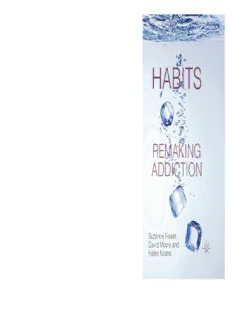
Habits: Remaking Addiction PDF
Preview Habits: Remaking Addiction
HABITS REMAKING ADDICTION Suzanne Fraser, David Moore and Helen Keane Habits: Remaking Addiction This page intentionally left blank Habits: Remaking Addiction Suzanne Fraser NationalDrugResearchInstitute,CurtinUniversity,Australia David Moore NationalDrugResearchInstitute,CurtinUniversity,Australia and Helen Keane SchoolofSociology,AustralianNationalUniversity,Australia ©SuzanneFraser,DavidMooreandHelenKeane2014 Softcover reprint of the hardcover 1st edition 2014 978-1-349-33888-7 Allrightsreserved.Noreproduction,copyortransmissionofthis publicationmaybemadewithoutwrittenpermission. Noportionofthispublicationmaybereproduced,copiedortransmitted savewithwrittenpermissionorinaccordancewiththeprovisionsofthe Copyright,DesignsandPatentsAct1988,orunderthetermsofanylicence permittinglimitedcopyingissuedbytheCopyrightLicensingAgency, SaffronHouse,6–10KirbyStreet,LondonEC1N8TS. Anypersonwhodoesanyunauthorizedactinrelationtothispublication maybeliabletocriminalprosecutionandcivilclaimsfordamages. Theauthorshaveassertedtheirrightstobeidentifiedastheauthorsofthis workinaccordancewiththeCopyright,DesignsandPatentsAct1988. Firstpublished2014by PALGRAVEMACMILLAN PalgraveMacmillanintheUKisanimprintofMacmillanPublishersLimited, registeredinEngland,companynumber785998,ofHoundmills,Basingstoke, HampshireRG216XS. PalgraveMacmillanintheUSisadivisionofStMartin’sPressLLC, 175FifthAvenue,NewYork,NY10010. PalgraveMacmillanistheglobalacademicimprintoftheabovecompanies andhascompaniesandrepresentativesthroughouttheworld. Palgrave®andMacmillan®areregisteredtrademarksintheUnitedStates, theUnitedKingdom,Europeandothercountries. ISBN 978-1-349-33888-7 ISBN 978-1-137-31677-6 (eBook) DOI 10.1057/9781137316776 Thisbookisprintedonpapersuitableforrecyclingandmadefromfully managedandsustainedforestsources.Logging,pulpingandmanufacturing processesareexpectedtoconformtotheenvironmentalregulationsofthe countryoforigin. AcataloguerecordforthisbookisavailablefromtheBritishLibrary. AcatalogrecordforthisbookisavailablefromtheLibraryofCongress. Transferred to Digital Printing in 2014 Contents ListofFiguresandTables vi Acknowledgements vii ListofAbbreviations ix Introduction 1 1 ModelsofAddiction 26 2 StabilisingStimulants:AmphetamineDependence andMethamphetamineAddiction 60 3 MakingMethamphetamineinDrugPolicy andConsumerAccounts 91 4 AFieldinDisarray?TheConstitutionofAlcoholAddiction inExpertDebates 128 5 AssemblingAlcoholProblems:YoungPeopleandDrinking 165 6 Junk:TheNeuroscienceofFoodAddictionandObesity 188 7 SteppingtotheSideofAddiction:EverydayRealities ofOvereatingandObesity 213 Conclusion:AMultiverseofHabits:‘Addicting’Science,Policy andExperience 234 Appendix:InterviewDataCollectionMethods 243 Notes 245 Bibliography 248 Index 262 v Figures and Tables Figure 4.1 Mainandinteractiveeffectsofgeneticand environmentalriskfactorsforalcoholism 149 Tables 1.1 DSM-IV substancedependencecriteria 31 1.2 DSM-5opioidusedisordercriteria 32 vi Acknowledgements ThisbookispartlybasedonthreeresearchprojectsfundedbyAustralia’s national competitive grant bodies, the Australian Research Council and the National Health and Medical Research Council (details in the Appendix). We would like to acknowledge this support and note the valueofsuchschemesinhelpingmakepossiblelarge-scalesociological research of the kind reflected in this book. The authors were based at two institutions: the National Drug Research Institute (NDRI), Faculty ofHealthSciences,CurtinUniversityandtheCollegeofArtsandSocial Sciences,AustralianNationalUniversity(ANU).TheNDRIissupported byfundingfromtheAustralianGovernmentundertheSubstanceMis- usePreventionandServiceImprovementGrantsFund.Wearegrateful for the support we received from our colleagues during the process of writing this book. We are also grateful to Sweden’s alcohol and other drugresearchcentre,SoRAD,basedatStockholmUniversity,foracting ashostsduringthemonthweenjoyedasvisitingscholarsin2013. Ofcourse,eachofusalsodrewsupportandinspirationfromdifferent sources,andourindividualacknowledgementsappearbelow. Suzanne Fraser This book was made possible by the intelligence, skill and perseverance of my co-authors, David Moore and Helen Keane. It has been an absolute pleasure to work with them on this ambitious project, and I look forward to more collaboration in the future. Over the last two years, I have spent time at the National Centre in HIV SocialResearch(nowCSRH)UNSW,whereIamavisitingseniorresearch fellow, as well as at NDRI, and I thank the staff at both centres for theircollegialityandfriendship.TomyremarkablefamilyIextendmy warmestthanksfortheirindispensablesupport. DavidMooreI’mextremelygratefulfortheopportunitytocollaborate with co-authors Suzanne Fraser and Helen Keane. I can’t think of two peopleI’dratherworkwith–theiracuteinsights,exceptionalgeneros- ity and (frankly incomprehensible) modesty make them ideal research colleagues.Ithankmycolleagues–atNDRIandbeyond–fortheirsup- port and interest. And special thanks to Suzanne, Joe and Charlie for everythingelse. vii viii Acknowledgements Helen Keane Deep-felt thanks to Suzanne Fraser and David Moore for inviting me onto this project. Working with them has been intellectu- allyrewardingandagenuineuncomplicatedpleasure.I’despeciallylike toacknowledgeSuzanne’sefficientandthoughtfulprojectmanagement. Completion of the manuscript was enabled by a visiting fellowship at the NDRI, Curtin University, and a semester’s research leave provided by the College of Arts and Social Sciences, ANU. I am grateful for the collegialityandfriendshipofmycolleaguesattheSchoolofSociology, ANU. MythanksasalwaystoDaniel,LeonandJuliusfortheirloveand encouragement. General Parts of the chapters to follow have already appeared in print. We are pleased to acknowledge the publishers’ permission to include them. Sections of Chapter 1 appeared in Keane, H. (2012) Diagnosing drug problems and the DSM. Contemporary Drug Problems, 39(3): 353–371, and are reproduced with permission from Federal Legal Publications. Tables 1 and 2 in Chapter 1 are reproduced from the Diagnostic and Statistical Manual of Mental Disorders DSM-IV-TR and the Diagnostic and Statistical Manual of Mental Disorders DSM-5, with permission from the American Psychiatric Association. Sections of Chapter 3 appeared in Fraser,S.andMoore,D.(2011).Governingthroughproblems:Thefor- mulationofpolicyonamphetamine-typestimulants(ATS)inAustralia. International Journal of Drug Policy, 22(6): 498–506, and are reproduced withpermissionfromElsevier.Figure1inChapter4appearedinDucci, F. & Goldman, D. (2008). Genetic approaches to addiction: Genes and alcohol.Addiction,103:1414–1428,andisreproducedwithpermission from Wiley. Sections of Chapter 6 appeared in Fraser, S. (2013). Junk: Overeating and obesity and the neuroscience of addiction. Addiction Research&Theory,19(2):230–244. Abbreviations ANCD AustralianNationalCouncilonDrugs AOD alcoholandotherdrug APA AmericanPsychiatricAssociation ATS amphetamine-typestimulants BMI bodymassindex BPS BritishPsychologicalSociety CBT cognitivebehaviouraltherapy CIDI compositeinternationaldiagnostic interview DSM DiagnosticandStatisticalManualofMental Disorders ED emergencydepartment MCDS MinisterialCouncilonDrugStrategy (Australia) MMT methadonemaintenancetreatment NDARC NationalDrugandAlcoholResearchCentre (Australia) NIAAA NationalInstituteonAlcoholAbuseand Alcoholism(USA) NIDA NationalInstituteonDrugAbuse(USA) NIMH NationalInstituteofMentalHealth(USA) NRT nicotinereplacementtherapy OCD obsessive-compulsivedisorder OFC orbitofrontalcortex ONDCP OfficeofNationalDrugControlPolicy(USA) PET positronemissiontomography SAmDQ SeverityofAmphetamineDependence Questionnaire SDS SeverityofDependenceScale STS scienceandtechnologystudies SUD substanceusedisorder UNDCP UnitedNationsDrugControlProgramme WHO WorldHealthOrganization ix
